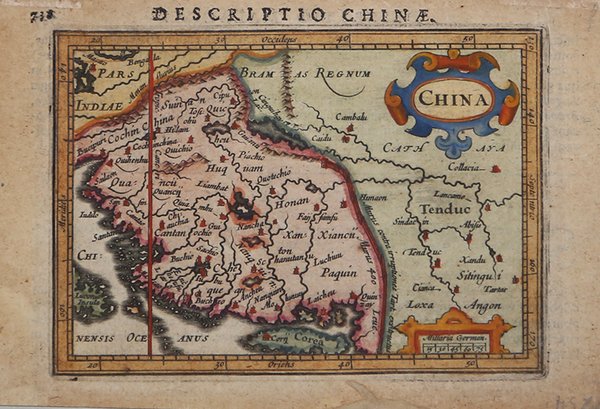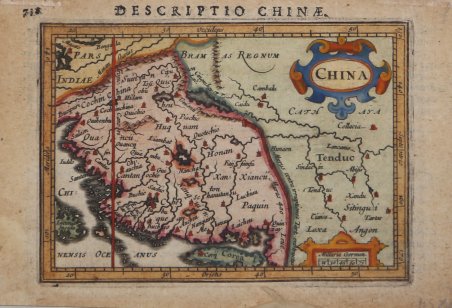Carta geografica tratta dal ' Tabularum Geographicarum contractarum libri septem ' di Petrus Bertius, edizione latina del 1616. L'opera contiene 219 carte che illustrano questa nuova versione della geografia del Bertius, per la prima volta pubblicata nel 1612 con le carte di Barent Langenes. Le carte derivano dal grande atlante di Mercator/Hondius, delle quali molte rappresentano una semplice riduzione. "After the death of Cornelis Claesz in 1609, Jodocus Hondius II became the new publisher of the work, composed by 7 parts in 1, with engraved title-page and 220 full-page engraved maps in text. All the maps were newly engraved and slightly larger in size, because Hondius was not able to acquire the original plates. With the new plates the work was definitely improved and enjoyed a growing demand of the public, which at that time had the choice between the ' Atlas Minor ' by Mercator and Bertius' ' Tabularum Geographicarum. The 219 plates, with the oval world map appearing twice, were produced to illustrate a new version of the geography of Bertius, published in 1616. According to King, their correct attribution is by Hondius, after Mercator and Hondius, taken from Bertius, who was only responsible for revising his text again" [cfr. G. King, ' Miniature Antique Maps]. “This map of China still follows the model and the orientation (with the West on top) of Ortelius 1584. Beijing is shown at around 40 degrees of latitude, under the name of Quinzay used by Marco Polo. Most features of the map look very similar to how China was portrayed on Pieter van den Keere's Asian map of 1614 (Schilder 2000, 144-146). On this map the Great Wall appears to be built in the middle of a plain north of Beijing, rather than among mountain ranges as in Ortelius's map; while the mountains still guard the western border. The lack of northern mountains was a feature on the Plancius 1594 world map and its followers, the maps in the Caert- Thresoor of Cornelis Claesz. In this drawing Bertius repeats the phrase on Ortel- ius's 1584 map: Murus contra irruptiones Tart. extructus Murus 400 Leuc. (a wall, built against the Tartar raids; a 400-league wall), but omitting Ortelius' report about the wall being built in the middle of sharp mountain peaks. Korea, shown as an island as on the Langenes map, appears to be protected by the Wall also, as the Wall is depicted to extend eastwards beyond Liaodong. In the text, Bertius repeats the names of the provinces listed in the Caert- Thresoor, without correcting the errors. He presented the provinces in two groups: six maritimae (coastal), and nine mediterraneae (landlocked). Petrus Bertius (1565-1629) was a theologian, historian, geographer, and cartog- rapher. In the history of cartography, he is famous for his work on the Caert- Thresoor (Van der Krogt 2003, 8410:342; entry 8) and for his edition of Ptolemy's Geography: Theatrum geographiae veteris, 1619. He was the brother-in-law of Pieter van den Keere (1571-after 1646), who married Bertius's sister, Anneke, in 1599. Van den Keere's sister Colette, in turn, married Jodocus Hondius, making Bertius also the brother-in-law of Hondius. Having been a personal friend of the theologian Jacobus Arminius (1560-1609), he was involved in a confessional controversy. In 1618 he moved to France, where he remained until his death. He became cosmographer and historiographer to the French King Louis XIII (1601- 1643) and converted to Catholicism. While in France he had access to a manu- script of al-Idrisi and used it to create a Ptolemaic map based on Arabic sources (Tolmacheva 1996). Jodocus Hondius (1593-1629), also known as Jodocus II or Jodocus Jr. to distin- guish him from his father (entry 11), was a printmaker and bookseller in Amster- dam (Van der Krogt 1997, 35). He pursued his father's work for some years until he died in 1629. After his death, thirty-six map plates were purchased by Willem Jansz. Blaeu. In 1616 a newly engraved series of plates was made for Bertius's . A superior rival to the pocket Ortelius atlas appeared about 1598, under the imprint of Barent Langenes and Cornelis Claesz. Claesz also published the ' Tabularum Geographicarum contractarum libri septem, edition with texy by Petrus Bertius, in 1600. After the death of Cornelis Claesz in 1609, Jodocus Hondius II became the new publisher of the work, composed by 7 parts in 1, with engraved title-page and 220 full-page engraved maps in text. All the maps were newly engraved and slightly larger in size, because Hondius was not able to acquire the original plates. With the new plates the work was definitely improved and enjoyed a growing demand of the public, which at that time had the choice between the ' Atlas Minor ' by Mercator and Bertius' ' Tabularum Geographicarum. The 219 plates, with the oval world map appearing twice, were produced to illustrate a new version of the geography of Bertius, published in 1616. According to King, their correct attribution is by Hondius, after Mercator and Hondius, taken from Bertius, who was only responsible for revising his text again. "After the death of Cornelis Claesz in 1609, Jodocus Hondius II became the new publisher of the work, composed by 7 parts in 1, with engraved title-page and 220 full-page engraved maps in text. All the maps were newly engraved and slightly larger in size, because Hondius was not able to acquire the original plates. With the new plates the work was definitely improved and enjoyed a growing demand of the public, which at that time had the choice between the Atlas Minor by Mercator and Bertius' Tabularum Geographicarum. The 219 plates, with the oval world map appearing twice, were produced to illustrate a new version of the geography of Bertius, published in 1616. According to King, their correct attribution is by Hondius, after Mercator and Hondius, taken from Bertius, who was only responsible for revising his text again" [cf. G. King, ' Miniature Antique Maps]. “This map of China still follows the model and the orientation (with the West on top) of Ortelius 1584. Beijing is shown at around 40 degrees of latitude, under the name of Quinzay used by Marco Polo. Most features of the map look very similar to how China was portrayed on Pieter van den Keere's Asian map of 1614 (Schilder 2000, 144-146). On this map the Great Wall appears to be built in the middle of a plain north of Beijing, rather than among mountain ranges as in Ortelius's map; while the mountains still guard the western border. The lack of northern mountains was a feature on the Plancius 1594 world map and its followers, the maps in the Caert- Thresoor of Cornelis Claesz. In this drawing Bertius repeats the phrase on Ortel- ius's 1584 map: Murus contra irruptiones Tart. extructus Murus 400 Leuc. (a wall, built against the Tartar raids; a 400-league wall), but omitting Ortelius' report about the wall being built in the middle of sharp mountain peaks. Korea, shown as an island as on the Langenes map, appears to be protected by the Wall also, as the Wall is depicted to extend eastwards beyond Liaodong. In the text, Bertius repeats the names of the provinces listed in the Caert- Thresoor, without correcting the errors. He presented the provinces in two groups: six maritimae (coastal), and nine mediterraneae (landlocked). Petrus Bertius (1565-1629) was a theologian, historian, geographer, and cartog- rapher. In the history of cartography, he is famous for his work on the Caert- Thresoor (Van der Krogt 2003, 8410:342; entry 8) and for his edition of Ptolemy's Geography: Theatrum geographiae veteris, 1619. He was the brother-in-law of Pieter van den Keere (1571-after 1646), who married Bertius's sister, Anneke, in 1599. Van den Keere's sister Colette, in turn, married Jodocus Hondius, making Bertius also the brother-in-law of Hondius. Having been a personal friend of the theologian Jacobus Arminius (1560-1609), he was involved in a confessional controversy. In 1618 he moved to France, where he remained u. Cfr.


Découvrez comment utiliser
Découvrez comment utiliser

